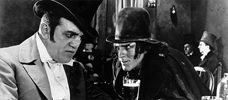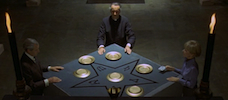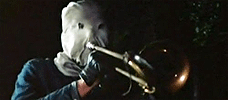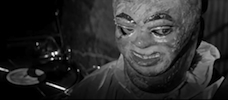Reviews
Night Drive
E.W. Swackhamer
USA, 1977
Credits
Review by Thomas Scalzo
Posted on 25 October 2010
Source Netflix Instant
Categories 31 Days of Horror VII
For our final made-for-TV terror offering of the month, we return to the desert, and to a suspenseful saga of a lone woman oppressed by a determined adversary. Unlike Dying Room Only, however, which immobilizes its heroine and slowly torments her with an inscrutable fear, Night Terror never allows its protagonist a moment’s rest and pits her against a nemesis whose motivations are delineated early on. Thus, instead of Cloris Leachman in a motel wondering why she is made to suffer, we have Valerie Harper on the highway trying desperately to escape a man who has made clear his intentions to kill her.
Setting the narrative wheels in motion is the hospitalization of Harper’s son, who happens to be in Denver. The fact that she is in Phoenix, and unable to fly to her boy owing to some inclement Colorado weather, compels her to set out on a late-night drive in the family station wagon. Soon after her journey begins, however, she happens upon a murder in progress on the side of the highway. And as bad luck would have it, she makes unwitting eye contact with the murderer. And as even worse luck would have it, she’s running out of gas.
The tension inherent in this simple - yet consistently effective - story is subtly enhanced at every turn by a succession of strategically introduced details. For starters, we have the fact that Harper’s character is introduced to us as a bit of a scatterbrain, a person incapable of handling complicated situations on her own. Next, we have the late-night drive through a particularly desolate stretch of the Southwest. Were this tale to take place on the East Coast, its plausibility would have taken a major hit. As it stands, the fact that not many other cars are on the road is not much of a surprise. Add on details ranging from a fierce rain storm, an avalanche of rocks blocking the road, a paucity of gas stations, and the difficulty in both finding a working payphone and having the correct change, and what we have is an engrossing tale that grips us more tightly with every new obstacle thrown Harper’s way.
While owing a clear debt to Duel and its enthralling tale of hunter versus hunted on the highway, Night Terror manages to set itself apart from Spielberg’s legendary made-for-TV creation in several respects. First, by doing away with the questions as to why our hero is being chased, we’re allowed to focus all of our attention on how Harper might escape her ordeal. In addition, the fact that the story here takes place primarily at night, and offers us two clear examples of what will happen to Harper should she fail in her escape efforts, leaves us with a film that eschews Duel’s undercurrent of metaphysical terror and focuses all its efforts on visceral horror. Finally, that our hero here is a woman, and that she arguably handles herself with more pluck and reserve than Dennis Weaver, speaks to the efforts of director E.W. Swackhamer to take the highway horror tale in a unique direction.
The night-scene focus of the film deserves particular attention, not only because it adds substantively to the tension, but also owing to the fact that lighting such a film - and one comprised primarily of cars driving on a highway, no less - must have been a significant challenge. Instead of allowing such concerns to limit the believability of the picture, or plunging us into perpetual darkness, we’re treated to an impressive assortment of creative lighting schemes that manage to increase the tension. From the halo of a streetlamp, to the haze of headlights, to the soft glow of dashboard running lights, what we can see in any given scene is severely restricted by whatever light source happens to be available. Such a circumstance ensures we’re kept on edge, always wondering if the killer is lurking just beyond what we can see.
Praise must also be proffered to Harper and her believable portrayal of a desperate mother determined to do whatever it takes to reach her sick child. Successfully selling us on her initial ineptitude, she also manages to convince us that she is a woman capable of fighting tooth and nail to survive, should the occasion arise. Harper’s is a role that is both demure and feisty, calling for both restraint and action in equal measure. After all, though she is certainly determined to do what she must to survive this ordeal, she still has to think about her family, and thus cannot throw caution to the wind the way her single-minded pursuer can.
Harper’s performance, coupled with a tight screenplay, deft direction, and relentless pacing, leaves us with a wonderful example of how a made-for-TV fright film can entice, frighten, and entertain us without the need for big budgets, elaborate special effects, or extreme gore. Indeed, with little more than competent acting, concise writing, and efficient directing, this unsung genre delivers gripping stories of suspense, creepy tales of terror, and beguiling forays into imaginative worlds. Though teleterror may not have the cachet of big studio or even independent features, I hope that the few offerings we’ve highlighted this month will encourage horror fans everywhere to seek out the many hundreds of made-for-TV terror films out there awaiting rediscovery.
More 31 Days of Horror VII
-

The Thin Blue Line
1988 -

The Ninth Configuration
1980 -

Scream
1996 -

Dying Room Only
1973 -

Brain Dead
1990 -

Zombi 2
1979 -

Dracula Has Risen from the Grave
1968 -

The Storyteller
1988-1989 -

Dr. Jekyll and Mr. Hyde
1920 -

I Know What You Did Last Summer
1997 -

Don’t Be Afraid of the Dark
1973 -

Dark Age
1987 -

Inferno
1980 -

To the Devil a Daughter
UK / West Germany -

Trapped
1973 -

The Town that Dreaded Sundown
1976 -

Halloween H20: Twenty Years Later
1998 -

Killdozer
1973 -

Pin
1989 -

Frankenstein Created Woman
1967 -

Reptilicus
1961 -

Matango
1963 -

I Still Know What You Did Last Summer
1998 -

Night Terror
1977 -

Kuroneko
1968 -

Demons
1985 -

Paranoiac
1963 -

Let Me In
2010 -

The Phantom of the Opera
1925
We don’t do comments anymore, but you may contact us here or find us on Twitter or Facebook.



